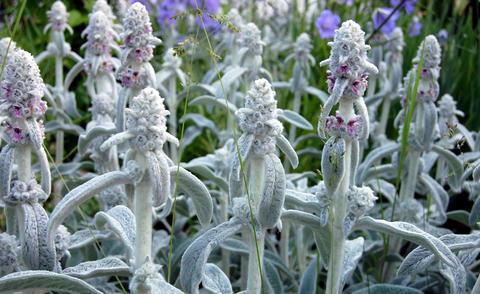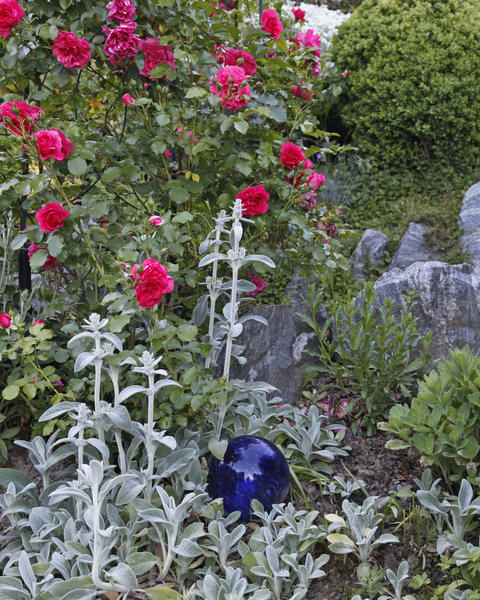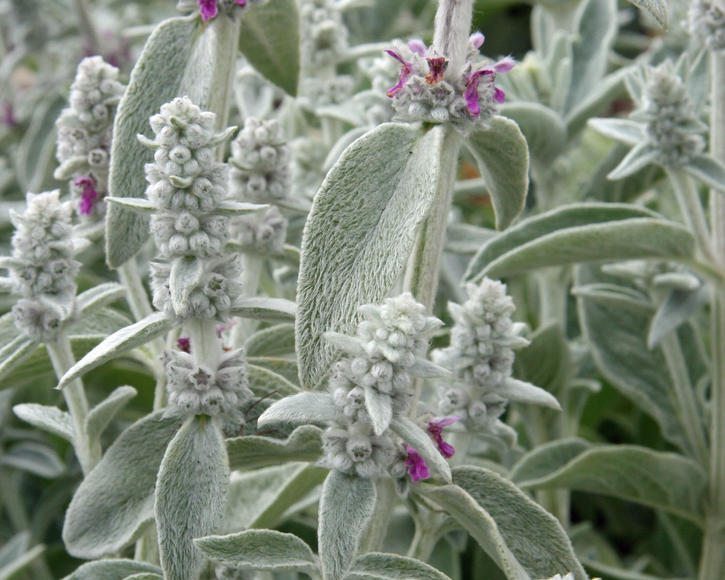Lamb’s-ear
Lamb’s-ear is robust, easy-care groundcover. It displays its wooly, soft, silver-gray leaves in flower beds and along path edges.
Factsheet
- Growth type
-
- Perennial plant
- Growth height (from)
- from 15 cm to 60 cm
- Growth characteristics
-
- upright
- cushion-forming
- Flower color
-
- red
- pink
- Flowering time (month)
-
- June to August
- Flower shape
-
- Candle-like
- whorls
- Leaf color
-
- green
- page format
-
- oval
- Sheet properties
-
- wintergreen
- Fruit color
-
- brown
- Fruit shape
-
- nut fruit
- Light
-
- sunny
- Soil type
-
- stony to sandy
- Soil Moisture
-
- dry to moderately dry
- ph value
-
- neutral
- Lime compatibility
-
- lime-tolerant
- Nutrient requirements
-
- moderately nutritious
- Humus
-
- low humus
- Decorative or utility value
-
- Leaf ornaments
- Winter Hardness
-
- hardy
- Climate zones according to USDA
-
- 5
- areas of life
-
- FR1
- FS
- Use
-
- Flowerbeds
- ground cover
- Embankments
- Borders
- Group planting
- Rose companion
- Surface greening
- Garden style
-
- cottage garden
- Flower garden
- Roof Garden
- natural garden
- Rose Garden
- Stone Garden
- Bee Friendly
- bee friendly plant
Lamb’s-ear (Stachys byzantina) belongs to the genus of Stachys which in turn is counted among the Lamiaceae family. It originates from the Near East and the Caucasus. It gets the name Lamb’s-ear due to its strokably soft leaves.
As a creeping, persistent groundcover shrub, Lamb’s-ear forms thick plant cushions over the years which can vary in height from 5.91 to 24 inches.
The oval shaped, felt-like leaves grow 9.84 to 20 inches long, depending on the variety. They are alternately arranged around the square stem and have wooly hair. These thick, fine-haired leaves feel as soft as fur. The hair on the leaves ensures that the Lamb’s-ear does not lose too much fluid when it is warm. It also retains its foliage in the winter months. The new shoots do not die until the spring.

The small, labiate flowers are less conspicuous and appear from June to August, depending on the variety, in pink or silver-white on long, gray inflorescences.
The mature nuts are long, brown-colored and hairless.
Lamb’s-ear likes full sun and is therefore particularly suitable for rock and roof gardens.
The sun-loving groundcover thrives in water-permeable soils. Lamb’s ear is very sensitive to waterlogging and winter dampness, so heavily compacted soils should be loosened and given a drainage layer of grit or gravel.

Lamb’s-ear is best planted in the fall, between September and November. In heavy, loamy soil, you should first work in a little sand in order to make the soil leaner and more permeable. Insert potted plants to exactly the same depth as they stood in the pot. Lamb’s-ear seeds can be sown directly in the flower bed in April. The seeds of this light-dependent germinator only require a light dusting of earth and should be kept evenly moist during the germination phase.
This extremely frugal shrub does not require any special care and or fertilizer. Watering is only necessary during persistent hot periods. The plant should be pruned after flowering in the spring.
Lamb’s-ear can be simply divided and replanted in the spring before it begins to grow shoots. But the lamb’s-ear the root ball should not be separated for this, instead, cut off the rooted leaf rosettes.
Lamb’s-ear is a popular ornamental foliage plant which provides a valuable service as groundcover as it forms interesting areas which give the effect of movement. It’s flowers are inconspicuous, but its felt-like, gray-green leaves give rose and shrub beds a picturesque appearance almost all year round. Lamb’s-ear can be used in the most varied of garden areas, as it also stands out in the winter with its attractive ornamental foliage. It is suitable for sunny, dry spots in cottage gardens, as an accompaniment to roses, on flower bed edges or in gravel beds. Over the years, Lamb’s-ear becomes really dominant, so more sensitive planting partners should be avoided. It also thrives in pots. The dried stems of Lamb’s-ear are beautiful in dried bouquets.

Lamb’s-ear Stachys byzantina ‘Big Ears’ grows heavily branched and has medium green leaves. The ‘Silver Carpet’ variety only grows around 7.87 inches tall and hardly forms any flowers. It forms a lot of offshoots and is ideal for roof and rock gardens.
Lamb’s-ear can be readily propagated through division in the early spring or after flowering. It is also possible to sow the seeds. 5.91 inch long shoots can also be used for cuttings. Plant in a propagation tray with a lean substrate and place in a shady spot in the garden and the cuttings will form roots.
Lamb’s-ear is largely resistant to pests. Too much water or shade has a negative effect on its growth.

